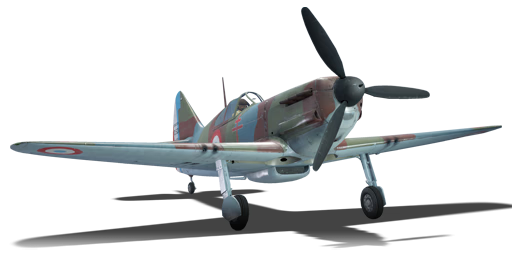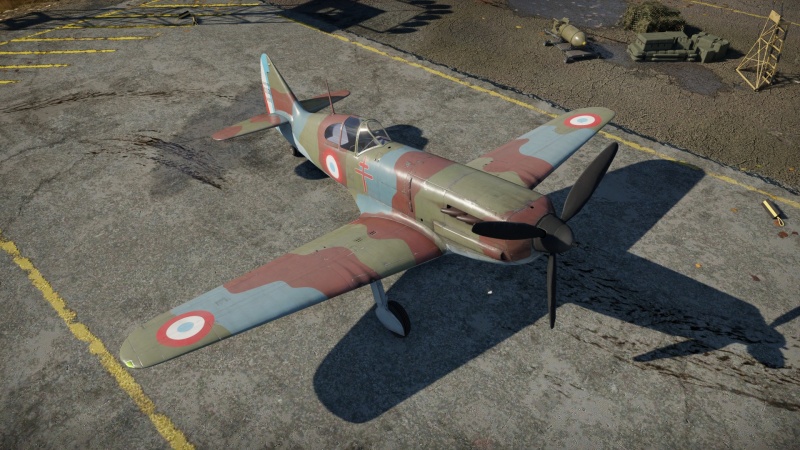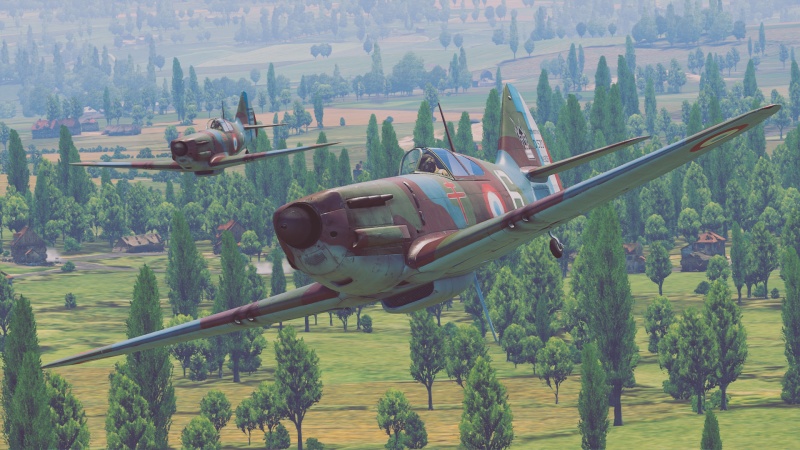D.520
| This page is about the French fighter D.520. For other versions, see D.520 (Family). |
Contents
Description
The Dewoitine D.520 was a French monoplane fighter employed during WWII and is considered by many as one of the best French-made fighters to be produced during WWII. The aircraft was powered by either the Hispano-Suiza 12Y-45 or 12Y-49 engines. The aircraft featured one Hispano-Suiza 20 mm cannon and four wing-mounted MAC 1934 7.5 mm LMGs. The plane served along both sides in the war, with both the Vichy and Free French air forces possessing a number of the aircraft, employed during the Battle of France with good results against the Luftwaffe and against the Italian Air Force, as well as in Syria in 1941 against British and Free French Forces alongside the German Luftwaffe.
Introduced in Update 1.73 "Vive la France", the D.520 has a mediocre handling in air battles. It has a decent turn time, but suffers from a low rate of climb and low top speed. Because of that the aircraft is best suited for Boom and Zoom, maintaining altitude and/or speed as a plan B in case you need to escape from an enemy. The aircraft requires good trigger discipline, at least for its 20 mm cannon, that only carries 60 rounds, meanwhile the 7.5 mm MGs have enough ammo to last for an entire match if used carefully, however, many times the MGs might be ineffective against heavier aircraft, like twin engine fighters and bombers.
General info
Flight performance
Due to the D.520's mediocre handling, each scenario must be exploited to the best for the maximum efficiency from the plane. However, maintaining a high speed with the aircraft is essential to do well in common dogfighting tactics such as Boom & Zoom and Turn & Burn.
The best climb rate can be obtained with 220 km/h IAS and then slowly decreasing this speed to 180 km/h after 6000 m. For better cooling, 230 or 240 km/h are good too.
| Characteristics | Max Speed (km/h at 5,000 m) |
Max altitude (metres) |
Turn time (seconds) |
Rate of climb (metres/second) |
Take-off run (metres) | |||
|---|---|---|---|---|---|---|---|---|
| AB | RB | AB | RB | AB | RB | |||
| Stock | 529 | 515 | 11200 | 21.1 | 21.9 | 7.1 | 7.1 | 300 |
| Upgraded | 571 | 550 | 19.0 | 20.0 | 13.6 | 10.0 | ||
Details
| Features | ||||
|---|---|---|---|---|
| Combat flaps | Take-off flaps | Landing flaps | Air brakes | Arrestor gear |
| ✓ | ✓ | ✓ | X | X |
| Limits | ||||||
|---|---|---|---|---|---|---|
| Wings (km/h) | Gear (km/h) | Flaps (km/h) | Max Static G | |||
| Combat | Take-off | Landing | + | - | ||
| 800 | 320 | 385 | 365 | 280 | ~12 | ~9 |
| Optimal velocities (km/h) | |||
|---|---|---|---|
| Ailerons | Rudder | Elevators | Radiator |
| < 370 | < 400 | < 430 | > 340 |
Survivability and armour
- 38 mm Bulletproof glass in front of pilot.
- 8 mm Steel plate behind pilot.
- 3 mm Steel box behind pilot's head.
Modifications and economy
Armaments
Offensive armament
The D.520 is armed with:
- 1 x 20 mm Hispano 404 cannon, nose-mounted (60 rpg)
- 4 x 7.5 mm MAC 1934 machine guns, wing-mounted (675 rpg = 2,700 total)
Usage in battles
This fighter is the classic "jack of all trades, master of none". It can be an energy fighter, bomber hunter, or even a turn-fighter. It depends on your playstyle, and the kinds of enemy aircraft that are encountered. During the battle you have to keep in mind your best climb speed is 220 km/h (IAS) allowing you to reach a good 18 m/s. Your engine power will always increase due to the linear compressor giving you your best flight performance at 4000 m.
The main purpose of the D.520 is the role of an interceptor/fighter. It has no bombing capability and thus stands limited to aerial combat. In this respect there are a few things to consider, first and foremost that this is a fighter that does not do great away from a squad. It has mediocre flight characteristics as far as speed, climb and turn is concerned. It is however quite well armoured to compensate for such, meaning that it will stay air-worthy where other aircraft would crash, and instead stands a fighter which is effective in engagements where it has support to rely on. Without such support, it is a very situational plane which can engage certain enemies depending on advantage in altitude, speed, or sometimes even a turning radius. It has a respectable armament of one powerful Hispano 20 mm cannon with a very limited ammunition load (60 rounds), and four 7.5 mm guns with a good deal of ammunition which makes it competitive in Realistic battles. Its strong airframe is able to withstand significant wind resistance making it potent in a longer dive. Despite its limited attributes it handles fairly comfortably and thus can be a real asset to a pilot which employs situational awareness combined with an in depth understanding of the enemy aircraft he will choose to either engage or avoid. It has a potent incendiary tracer round for its machine guns and the Hispano makes it pack a fairly significant punch despite its limited cannon ammunition. The D.520 is best considered a heavier single-seat fighter aircraft which can out-endure other enemy squads due to its armour, but not out-turn, out-run, or out-gun many other types of aircraft on its own rank.
Once the weaponry upgrades are unlocked, it's recommended to use the tracer belt for the 7.5 mm guns and the "Stealth" for the Hispano cannon. Since there are no Air targets belt for the cannon, the Stealth have the strongest punch. Be very careful with the cannon ammo, only fire in controlled bursts with 2-3 shots. Do not use the cannon at longer range because of the limited ammo and the inaccuracy. Use the machine guns to help when aiming the Hispano.
The D.520 is capable for bomber hunting. It has good armour, not too bad climb rate, and the combination of the single 20 mm and four machine guns can easily destroy low rank bombers.
Enemies worth noting:
- Bf 109s: This plane is one of the D.520's most dangerous enemies. They can out-run you in level flight, but your turn rate is better, even without using combat flaps. So, the classic dogfight is the only way to counter them. Bf 109s have more engine power at all altitude, but the difference is almost gone at 4000 m where D.520 have the most power and then increase with altitude. A good way to deal with Bf 109 is to climb around 5000-6000 m and then bring the enemy plane to this altitude with a dogfight.
- A6M2/A6M3: As always, never go in a turnfight with them. The D.520 can easily out-run the Zero in a shallow dive or even in level flight. Head-ons are recommended, because the Hispano cannon can have devastating impact on their weak airframes, and the MGs are capable of causing fires.
- Spitfires: The D.520 is less likely to face them, but sometimes you need to fight with these excellent fighters. They are out-perform you almost all aspects. They have equal or better turn rate, comparable weaponry, better climb rate, and better speed. You have the least disadvantage in a turnfight, so bait the Spitfire into a low-altitude dogfight, and make him lose as much energy as possible. Now, you have a chance to get him from his six, and at this point you and your opponent both are "slow and low", so it's going to be an easy job for the friendly fighters to take him down, but you are good target for the enemy too, so be careful.
- F4U: These are quite common to face. You can out-turn them, but don't try anything else, almost all American fighters can catch you, especially in dive.
- P-38E: Same as the F4U; turn-fight them to bleed their speed, but don't try anything else, as the P-38 is faster, and has a deadly armament of 4 x 12.7 mm MGs, and the feared AN/M2 20 mm.
Manual Engine Control
| MEC elements | ||||||
|---|---|---|---|---|---|---|
| Mixer | Pitch | Radiator | Supercharger | Turbocharger | ||
| Oil | Water | Type | ||||
| Controllable | Controllable Not auto controlled |
Controllable Not auto controlled |
Controllable Not auto controlled |
Separate | Not controllable 1 gear |
Not controllable |
Pros and cons
Pros:
- Powerful 20 mm cannon
- Plenty of ammo for the machine guns
- Tracer belts are made up entirely of incendiary tracers; great fire starters, especially for fabric-covered aircraft
- Fairly good armour
- Quite manoeuvrable
- Respectable turn time
Cons:
- Very little ammo for the 20 mm cannon (60 rounds)
- Relatively poor rate of climb
- Very situational aircraft
- Takes a lot of machine gun rounds to shoot down a enemy plane if you run out of cannon ammo
History
Widely regarded as the best fighter of French origin to emerge during World War 2, the Dewoitine D.520's combat carrier had two main phases. After the fall of France, large numbers of the type were sent to Africa and some took part in the 1941 Syrian campaign against the British and Free French forces. Fighting alongside the German Luftwaffe, the D.520's pilots were involved in the fight against the Allies during the Operation Torch landings in November, 1942. After the victory of the Allies, a large number of D.520 pilots decided to change sides and fight for the Allies. The type was extensively used by Luftwaffe fighter schools as trainers, this shows the desperation faced by that service late in the war. Accident rates among students were very high.
Power-plant
The D.520 was powered by either the Hispano-Suiza 12Y-45 or 12Y-49 engines, rated at 850 hp (634 kW) and 820 hp (612 kW) respectively. Each engine drove a different propeller. The D.520 underwent trials for the more powerful 12Y-51 (D.523) and 12Z-89ter (D.524) engines although neither were accepted.
Armament
Compared to other French fighters at the time, the Dewoitine D.520 was relatively well armed. Its armament consisted of one Hispano-Suiza HS404 20 mm cannon with 60 rounds, and four wing-mounted 7.5 mm MAC 1934 machine guns, each with 675 rounds of ammunition.
Cockpit
The D.520's cockpit was set well in aft, giving it excellent downward vision in flight. However, taxiing was quite a tricky task. It required the pilot to weave to retain a semblance of forward visibility.
The D.520 over France
The D.520 fought with great distinction during the Battle of France. There were a number of notable victories against the Luftwaffe in the North, including the shooting down of the leading Luftwaffe ace Werner Mölders. In the South, the D.520's scored easy kills against the Italians who joined the war on the 10th of June. France's only "ace in a day" was Pierre Le Gloan, who shot down four CR.42s and a BR.20 in a single sortie in a D.520 on the 15th of June.
Media
- Skins
See also
- Related development
External links
- [War is Boring] France's D.520 Fighter Flew for Many Sides in World War II (Web Archive)
- [aviastar.org] Dewoitine D 520 (Web Archive)
- [History Of War] Dewoitine D.520 (Web Archive)
- [Avialogs] Descriptive and Usage Notice for the D.520. (in French)
| Dewoitine (SNCAM/SNCASE) | |
|---|---|
| Fighters | |
| D.37 | D.371 · D.371 H.S.9 · D.373 |
| D.500 | D.500 · D.501 · Pallier's D.510 |
| D.520 | D.520 · ▄D.520 · ▄D.521 |
| Export | ␗D.510C |
| France fighters | |
|---|---|
| Dewoitine | D.371 · D.371 H.S.9 · D.373 · D.500 · D.501 · Pallier's D.510 · D.520 |
| Morane-Saulnier | M.S.405C1 · M.S.406C1 · M.S.410 |
| Arsenal | V.G.33C-1 |
| Bloch | M.B.152C1 · M.B.157 |
| Caudron | C.R.714 |
| Sud-Ouest | S.O.8000 Narval |
| American | H-75A-1 · H-75A-4 · ▄P-39Q-25 · ▄P-40F-5 Lafayette · ▄P-47D-22-RE · ▄P-63C-5 · F-6C-10-NA |
| ▄F6F-5 · ▄F6F-5N · F4U-7 · ▄F8F-1B | |
| Other countries | ▄Seafire LF Mk.III · ▄Yak-3 · Challe's ▄Yak-9T · NC.900 |






